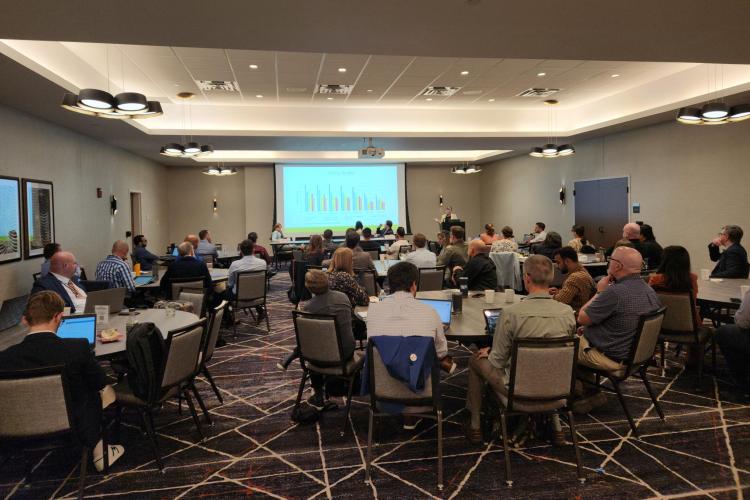
MEEA’s Buildings Team recently held its 14th Annual Midwest Building Energy Codes Conference in Indianapolis on September 13 - 14. As in years past, the conference brought together various stakeholders from the region- and beyond-, including municipal decisionmakers, city staff, builders, architects, utility policy managers, researchers, engineers and university directors.
Events kicked off Tuesday evening with a welcome reception for attendees. The conference officially began on Wednesday morning with Welcome Remarks from MEEA’s Buildings Director, Alison Lindburg, and the Executive Director of the newly formed Indiana Energy Independence Fund, Alex Crowley. Then, to set the stage for the rest of the conference, state-by-state updates were given regarding recent building energy code and policy adoptions, as well as new initiatives or goals to be tackled in the upcoming year. This “Midwest Roundup” session helped attendees understand the energy code landscape, policy advancement throughout the region and prepare them for the presentations they would see over the next two days.
The rest of the conference agenda offered a wide variety of speakers, topics and networking opportunities. On Wednesday, we held an interactive workshop in which people got to hear directly from college professors, builders and engineers about how to train and prepare the next workforce in code compliance. Potential methods included immersive virtual training and lab teaching in order to engage students who are new to energy efficient building construction or who are looking to expand their knowledge.
Then, the afternoon panel sessions touched on the benefits of off-site construction (i.e., the benefits to contractors, to building officials and to building owners) and how to improve the energy performance of existing buildings. For the latter session, presentations were given related to Indianapolis’ Energy Benchmarking and Transparency Ordinance, building performance standards in Denver and Colorado and Madison, Wisconsin’s Building Energy Savings program and Efficiency Navigator program. Wednesday wrapped up with a fun, relaxing reception at the Gallery Pastry Bar in downtown Indy.
The second day of the conference began with an impressive set of panelists discussing how to make an equitable impact with residential buildings. Of note, Adam Hammond with AES Indiana discussed the utility company’s strategies to implement its residential energy efficiency programs more equitably, namely through program participation, community engagement, earned customer trust and improved customer outcomes. Eric Hempel, the Manager of the Office of Sustainability for Columbia, Missouri, then presented on the city’s rental housing energy efficiency project– a project that is essential since the majority of Columbia’s residential building stock is multifamily rental housing. The Office of Sustainability has conducted thorough equitable stakeholder engagement with tenants, property managers/owners and community-based organizations by providing electronic and paper questionnaires, distributed by trusted community partners at accessible locations and provided compensation for people’s lived expertise. With this information, the city hopes to have a better understanding of the energy efficiency improvement potential, as well as potential partnerships that could be made to further implementation (e.g., cross-training with Home Energy Score for rental registrations and inspections, electrification support via utility incentives).
Discussing code compliance in hard-to-reach areas, MEEA’s Building Associate, John Gossman, first outlined the geographical, cultural and technological circumstances that define remoteness and went over past and current MEEA initiatives that help address these areas. Some initiatives mentioned were field studies, code compliance collaboratives and the circuit rider program. John also announced that MEEA is now working with the state of Alaska to learn what it is doing to address building energy efficiency in hard-to-reach areas, how that knowledge can be applied to other areas and how MEEA can be of assistance. Incidentally, Michael Spencer from the Alaska Housing Finance Corporation was in attendance and was able to speak about the state’s work personally. He discussed the challenges Alaska faces from both isolation and extreme weather conditions, including the fact that fuel, supplies and construction costs are much higher. However, he also recognized that the resilience and ingenuity of Alaskans are paramount to building and living in the region. To close out the panel, Gregory Donworth of ICF highlighted software the company uses to get a granular look at building energy use. Specifically, they use “smart meters” to gather data used to pinpoint energy burdened buildings and determine where the biggest impacts can be made.
Closing out the conference was an information-packed session on funding, resources and programs that are available to help people construct energy efficient buildings. We discussed federal funding opportunities for energy code development, adoption, implementation and enforcement processes, as well as funding through Michigan Saves, the nation’s first nonprofit green bank dedicated to accessible, equitable and just investments in energy efficiency improvements. Bill Brown, with Indiana University’s Environmental Resilience Institute, and Malachi Rein, with Building Energy Exchange – St. Louis, discussed the assistance offered by their “hubs” to help smaller communities competitively pursue federal funding opportunities and help building owners improve the energy performance of their properties through technical assistance and educational resources. Finally, Alyssa Hernandez, the Director of Community Development for Cleveland, Ohio, touched on the city’s updated Residential Tax Abatement program which incentivizes the construction of energy efficient homes and energy efficiency improvements.
MEEA prides itself on keeping the Midwest Building Energy Codes Conference casual and collaborative while also remaining informative and educational. This year was no different. All the sessions touched on innovative strategies, tools and mechanisms to advance building energy codes and policies. As we start to consider when and where the next codes conference will be held, we encourage people to complete this survey and provide their input on dates, locations and content. We look forward to seeing everyone next fall!